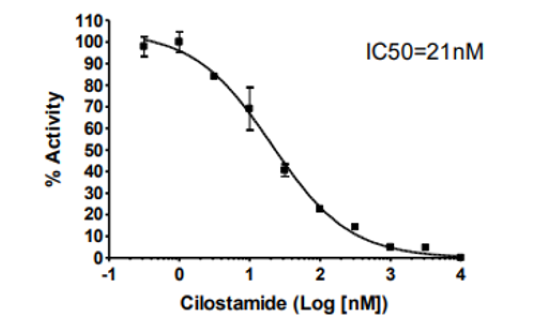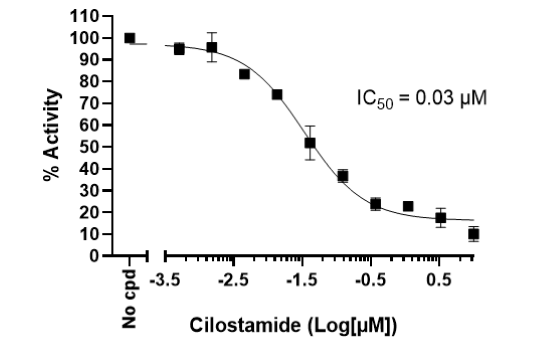PDE3A TR-FRET Assay Kit
The PDE3A TR-FRET Assay Kit is designed to provide fast and easy identification of inhibitors of PDE3A (phosphodiesterase 3A) using Time-Resolved Fluorescence Resonance Energy Transfer (TR-FRET). The PDE3A TR-FRET Assay Kit comes in a convenient 96-well or 384-well format, with enough recombinant purified PDE3A (amino acids 669-end) enzyme, fluorescently labeled PDE substrate (cAMP), binding agent, and PDE assay buffer for 100 or 384 enzyme reactions.

Figure 1: Illustration of the assay principle.
The reaction uses a fluorescein-conjugated (FAM) cyclic monophosphate nucleotide. Phosphodiesterase PDE3A catalyzes the hydrolysis of the phosphodiester bond in the cyclic monophosphate nucleotide, releasing the phosphate group for binding. The phosphate group binds to a “Binding Agent” (BA) that is recognized by terbium-labeled donor beads. This results in energy transfer from the terbium to FAM, which emits a fluorescent signal at 520 nm. If unbound to the phosphate group, the terbium-labeled beads emit at λ=490 nm. The fluorescent intensity is measured using a fluorescence plate reader capable of TR-FRET reading and an increase in 520 nm corresponds directly to the activity of PDE3A.
Need us to run inhibitor screens or profile your compounds against PDE3A? Check out our Phosphodiesterase Screening Services.
This product has been cited 1 time.
Fluorescent microplate reader capable of measuring Time Resolved Fluorescence Resonance Energy Transfer (TR-FRET).
96 reactions
| Catalog # | Component | Amount | Storage |
| 60032 | PDE3A, (669-end), His-GST-Tags* | >1 µg | -80°C |
| 60200 | 20 µM FAM-Cyclic-3′, 5′-AMP | 50 µl | -80°C |
| 60393 | PDE Assay Buffer | 25 ml | -20°C |
| 60394 | Tb Donor | 50 µl | -80°C |
| 60390 | Binding Agent | 200 µl | +4°C |
| 78422 | Binding Buffer A | 20 ml | +4°C |
| 78423 | Binding Buffer B | 20 ml | +4°C |
| 79685 | Black 96-well plate | 1 | Room temp |
*The concentration of the protein is lot-specific and will be indicated on the tube.
384 reactions
| Catalog # | Component | Amount | Storage |
| 60032 | PDE3A, (669-end), His-GST-Tags* | >1 µg | -80°C |
| 60200 | 20 µM FAM-Cyclic-3′, 5′-AMP | 50 µl | -80°C |
| 60393 | PDE Assay Buffer | 25 ml | -20°C |
| 60394 | Tb Donor | 50 µl | -80°C |
| 60390 | Binding Agent | 200 µl | +4°C |
| 78422 | Binding Buffer A | 20 ml | +4°C |
| 78423 | Binding Buffer B | 20 ml | +4°C |
| 781209 | Black 384-well plate | 1 | Room temp |
*The concentration of the protein is lot-specific and will be indicated on the tube.
Phosphodiesterases (PDEs) play an important role in the dynamic regulation of cAMP and cGMP signaling. PDE3A, also known as cGMP-inhibited phosphodiesterase, is activated by protein kinase A and B, and inhibited by cGMP. It has been implicated in cardiovascular functions by regulating the contractility of the heart muscle and vascular smooth muscle, and platelet aggregation. It has also been linked to fertility based on its expression in oocytes. Inhibitors for PDE3A and PDE3B showed some promise for cardiovascular disease treatment but can result in side effects such as arrhythmia. PDE3A has been found in lung and breast cancer, where it mediates cancer cell stemness by downregulating the cAMP/PKA pathway, and its level links to clinical prognosis. The use of PDE3A inhibitors results in reduction of breast cancer metastasis in animal models and may prove a powerful tool in cancer therapy.
Maurice, DH. Front. Biosci. 2005; 10:1221-8.



